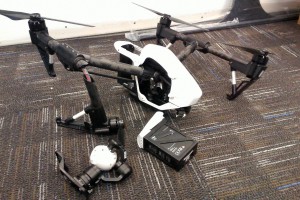Dangers of Flying Drones in Public Places
A University of Kentucky law student, Payton Wilson, allegedly crashed a drone equipped with a high-powered camera, into a stadium suite. The incident occurred during the UK season football opener against Louisiana-Lafayette in early September 2011. Wilson is charged with wanton endangerment. Endangerment is the act of exposing someone or something to danger, harm, or peril.
In Kentucky, an individual is guilty of this crime in the first degree when showing an extreme indifference to human life. The conduct may cause substantial death or serious injury to someone. Wanton endangerment is a second degree charge when the individual’s conduct creates substantial danger of physical injury. 
Wilson allegedly endangered the lives of military parachutist delivering American flags and a game ball to the pre-game show. The University of Kentucky’s police chief claimed it was very dangerous to operate a remote-controlled, non-piloted aircraft where there’s a lot of people. Wilson faces up to one year in jail.
A recent LegalMatch blog discussed drone technology and privacy issues. The task of determining whether or not a person could use a drone is currently left up to local jurisdictions.
Sports Injury is Any Injury Occurring at a Sporting Event
The criminal act of flying a drone in a stadium and having it crash into a suite poses another legal issue. If the drone had caused serious injury to someone sitting in the suite, would the injured bystander be allowed to sue?
In tort law, often referred to as personal injury law, an individual can sue a company or another person because harm or injury suffered. The defendant in this situation could be University of Kentucky and/ or Wilson.
A plaintiff’s injury caused by a drone crashing into a stadium suite is considered a spectator sports injury. This type of injury arises out of:
- An inherent hazard or risk of watching a sport
- Actions of a third party, sports team employee, or another spectator
- Hazardous defects to the equipment or arena that is unrelated to the sports event
Most spectator sports injuries aren’t successful because of assumption of risk. Assumption of the risk occurs when a person knows of the risks and dangers involved in a particular activity and voluntarily accepts those risks and dangers. For instance, a baseball player hits a foul ball. The ball travels into the stands and hits a spectator, breaking his nose. The spectator is liable for his own injuries. He knew there was a possibility of getting hit by a foul ball. He accepted the risks and went to see the game.
A drone crashing into a suite isn’t something a spectator would expect to occur while at a game. If one of the suite spectators was injured by the drone, he would have a legal claim to sue UK. He didn’t assume the risk of a drone injury.
Negligence is the Failure to Use Care an Ordinary Person would Use in Similar Circumstance
An individual injured by a flying drone would have a personal injury claim based on negligence. Negligence is the failure to use the amount of care an ordinary person would use in the same or similar situation. The standard of care can be based on an ordinary person, reasonable prudent person, or one with special skills. The exact “person” used to determine negligence depends on the circumstances. For instance, a doctor would be someone with special skills.
Negligence assumes an ordinary person like Wilson would use an amount of care to prevent harm when flying a drone. The plaintiff would have to show the defendant had a duty not to cause any injury while flying the drone.
Once a plaintiff can show a duty, the next element is breach of duty. Breach of duty refers to a person violating his duty not to cause harm. The person is in violation of his duty because he knows he’s putting another individual at risk or foreseen there was a risk in his activity. An individual injured after the drone crashed into the stadium suite is an example of a breach of duty to keep people safe.
For an act to be negligent, there must be a cause-in-fact, or cause of the accident. A plaintiff can show the defendant is liable in two ways:
- Indirect, or proximate cause
- Direct, or actual cause
If Wilson was sued, he’d be the direct cause of the accident because of the “but-for” test. But for Wilson, the plaintiff would have never been injured.
Once a plaintiff can successfully show those three elements, he’d have to prove damages. To receive money, the plaintiff must have incurred some damage or loss as the result of the defendant’s failure to exercise care. Damages include physical injury and/or financial loss.
It’s not know whether drone that hit the stadium suite caused injuries or not. Any individual injured by a drone would have to consult a lawyer to determine if the other person was liable for any injuries suffered.


Comments
Hi there, everything is going nicely here
and ofcourse every one is sharing facts, that’s genuinely
good, keep up writing.